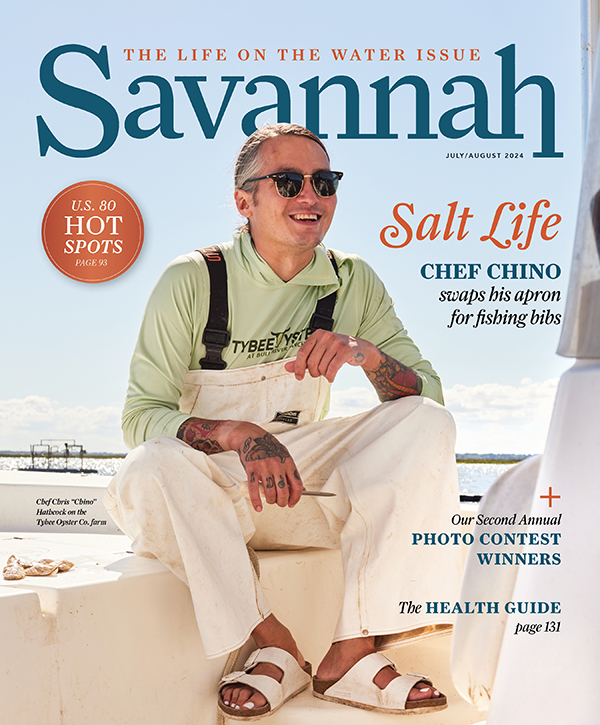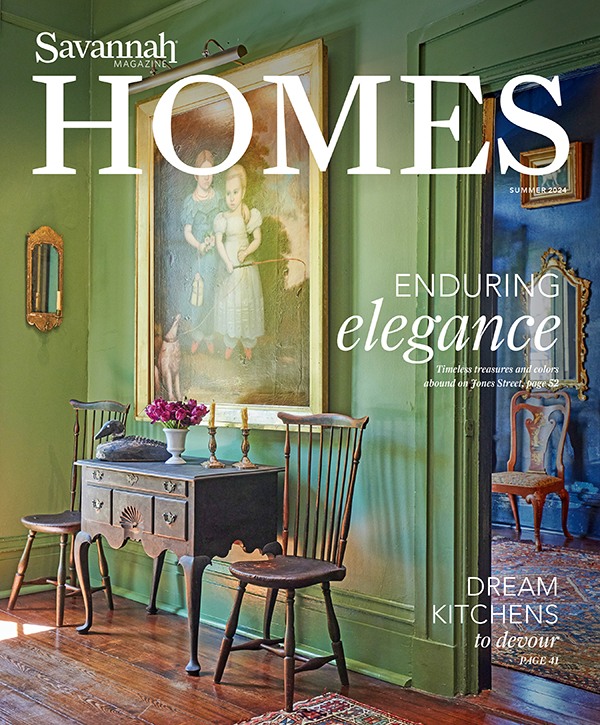Editor’s Note: After our March/April 2023 issue went to press, we are saddened to hear of the passing of Thomas H. Lee, husband of Ann Tenenbaum and a longtime supporter of Telfair Museums. Our thoughts are with the family.
RAISED UNDER THE mossy cover of Jones Street, Ann Tenenbaum grew up with some formidable housemates. Works by artists like Andy Warhol, Marc Chagall and Diego Rivera — household names for many — were also household fixtures at the Tenenbaums. Their art enlivened her family’s historic four-story townhome from the walls and tabletops they dotted.
Ann’s parents, the late Lorlee and Arnold Tenenbaum, were art collectors — fans of all things beautiful and avant-garde. A clan of go-getters, the Tenenbaums became notable for their business acumen (Arnold was president of Chatham Steel), philanthropic efforts and fierce advocacy of the arts. This legacy now continues in two brilliant exhibitions at Telfair Museums’ Jepson Center.

The first, “Photography’s Last Century: The Ann Tenenbaum and Thomas H. Lee Collection” (February 17 – May 21), offers viewers a world-class, comprehensive study of photography’s development in the 20th century. Then, the second exhibition, “Bold Expressions: The Collection of Lorlee and Arnold Tenenbaum” (March 10 – July 9), features more than three dozen beloved prints, drawings, paintings and ceramics collected over the couple’s decades together.
Originally displayed at the Metropolitan Museum of Art in New York, “Photography’s Last Century: The Ann Tenenbaum and Thomas H. Lee Collection,” opened on March 10, 2020, just days before the COVID-19 pandemic closed the venerable institution’s doors for months. Tragically, Arnold and Lorlee died in March 2020, just five days apart from each other — the pandemic’s first victims in Chatham County.

When Telfair Museums offered a second showing in her hometown, inside the Moshe Safdie-designed building her father’s vision and patronage brought to fruition, Ann eagerly accepted the chance to exhibit her favorite pieces again.
“I am doing this for my parents. I know we are all sad that they can’t be there to see this because they would have loved it so much,” says Tenenbaum. “It’s about feeling like I want to do something impactful and exploring myself and my roots and my family.”
A display of first-rate landscapes, experimental portraits and documentary pieces from 1916 – 2018, Ann’s collection features its own Warhol — this one a photo-booth self-portrait series of the artist holding his sunglasses askew on his face — alongside pieces by Diane Arbus, Cindy Sherman, Man Ray, Richard Avedon and Paul Strand.
“These photographs are a textbook of the biggest names in the field of photography,” says Alex Mann, Telfair Museums’ chief curator and director of curatorial affairs. “But that wasn’t Ann’s goal when collecting pieces. She wasn’t following a checklist. She was finding pieces she especially loved. She loves the story of the work and the artist.”

The show carefully chronicles many artists’ early works — tracing their beginnings and first attempts at mastering the rapidly evolving medium in the 20th century. For instance, a nine-part self-portrait series depicts a 22-year-old Cindy Sherman, bare-shouldered and lipsticked, captivatingly emoting for the camera. There is one still left completely blank — no subject to be found. One of Sherman’s later iconic works, a “film still” depicting a woman looking out over the bucolic landscape, a suitcase beside her feet, is also on display.
Beyond static images, a video collaboration between Icelandic artist Ragnar Kjartansson and American rock band, The National, will be on view four times throughout the exhibition’s tenure. The six-hour meditative performance entitled “A Lot of Sorrow” was filmed in New York at MoMA’s PS1 Sunday Sessions in 2013 and, according to Mann, is unmissable.
“It is a weighty and exciting, beautiful, meditative and poetic experience,” says Mann.
The other non-image-based work is a novelty for Telfair Museums and a project near and dear to Ann’s heart: an improvisational soundtrack created especially for the exhibition by Icelandic composer Davíð Þór Jónsson. Wandering from image to image, visitors will be delighted by the original score, meant to “inspire, inform and create a multisensory experience for this exhibition,” Mann says.
While Ann may have gained her penchant for art from her parents, viewers will note the display styles and works collected by Ann and her husband, Thomas, are distinct from those of the elder Tenenbaums.
“[The parents’] collection is very diverse and colorful with two-dimensional and three-dimensional pieces, and is quite eclectic,” says Mann. “[The other is] a collection of photography that is carefully focused on fine, experimental and page-turning works by iconic photographers from around the world over the past 100 years.”
For Ann, her art appreciation is more nurture than nature.
“My mother did everything on instinct and, luckily, she had great instincts. It was wonderful and complicated,” says Ann of her childhood in an eclectic, bustling home — not unlike that of the fictional cinematic characters who share her surname. (Wes Anderson and Owen Wilson are friends of the family).
“Sometimes having these [artworks] hanging in my home was tough because I didn’t like or understand them. Friends would come over and say, ‘What is this? I could make this.’ I was too young to have cogent arguments against it,” says Ann. “It was inspiring and embarrassing, but that discomfort made me ask all kinds of questions. It helped inform my own taste and understanding of how art can be complicated as well as beautiful and profound.”
Lorlee and Arnold’s enjoyment of antiquity and resonance with the profundity of modernity are apparent in their collection.

“The love [Lorlee and Arnold] had for the Savannah community and [its] history, coupled with a determination to continually think forward for the future of what Savannah is and could be, is really evident in the fight to get the Jepson Center built — a very long process Arnold was very deeply involved in,” says Erin Dunn, Telfair Museums’ curator of modern and contemporary art. “He knew it could bring a lot of great programming, community building, 21st-century architecture to the city, and reflect that there is this constant struggle between old and new, but that, ultimately, it is for the benefit of the community.”
“Bold Expressions” honors these efforts and commemorates the visionary collectors and the works they surrounded themselves within their Savannah residences.
“The initial concept was a series of conversations between Telfair Museums and the family about the future of Lorlee and Arnold Tenenbaum’s collection and how the museum could honor them,” says Dunn. “The curatorial team selected a number of works based on the quality [and] visual impact of the work, the diversity of the artists, the scale of the pieces, the importance of the artist to art history, the varieties of mediums [and] the regional importance of some of the artists.”

“Art has always been a part of our lives and an extension of the way we’ve lived,” Arnold told the Savannah Morning News in 2019. “And the way [our children] were raised.”
Now on the walls of the Jepson Center, scattered among a sea of dazzling works that once bedecked their home, a notable, screen-printed collage of Mick Jagger by Andy Warhol, a silhouette linocut by the prolific Kara Walker, a David Shapiro painting (purchased by the couple to celebrate their 1959 engagement) and a contemplative image of SCAD professor Zig Jackson, sitting on the riverbank donning a feathered war bonnet and modern clothing, are all sure to intrigue both art aficionados and casual museum hoppers.
“Everyone will be blown away by the pop culture references and how bright and colorful [the piece] is,” Dunn says of the Rolling Stones frontman’s portrait. “It’s going to be great to see which pieces people really latch onto.”

One of Dunn’s favorite pieces, an untitled drawing depicting enigmatic figures and signage spread across a horizontal line by local artist Phillip J. Hampton underscores Lorlee and Arnold’s modern and diverse approach to collecting. Hampton, a former Savannah State University visual arts professor and department head, developed a multimedia oeuvre ranging from realism to abstract experimentalism. Telfair Museums recently organized the largest museum retrospective of Hampton’s work to date in collaboration with Savannah State University.
The Hampton piece can be traced to a 1972 feature of the Tenenbaums’ Jones Street home in House Beautiful.
“It shows how they supported artists of their time and their city [and] it’s exciting for me to know collectors like Lorlee and Arnold were meeting with Hampton and collecting his work during the time it was being made in the 1950s and ’60s,” Dunn says.

“[Having these artworks hanging in my home]was inspiring and embarrassing, but that discomfort made me ask all kinds of questions. It helped inform my own taste and understanding of how art can be complicated as well as beautiful and profound.” — Ann Tenenbaum

More than a visual feast, the range of works exhibited begs the viewer to search out their favorite pieces and become a collector themselves — to live with art, just as Lorlee and Arnold boldly did.
“With each house, they showed how people could live with art in various settings and really make it part of their lives,” Dunn says.
Beyond inspiring their own home galleries, Ann expects the shows to bring viewers a deep sense of satisfaction and joy.
“I hope they feel pleasure — the joy of looking at beautiful objects. For me, beauty is a big part of collecting,” Ann says. “I hope it will stimulate ideas in people about what it means to be human in all different iterations. There is art by Native Americans, and the last piece I bought that will be on view is a portrait by a non-binary artist in South Africa [named] Zanele Muholi. I think [the exhibit] reflects an incredible span of ideas and culture and civilization.”
And an incredible picture of the inimitable family.



